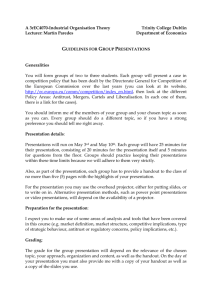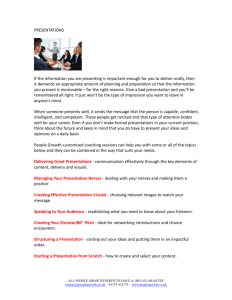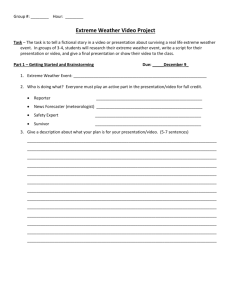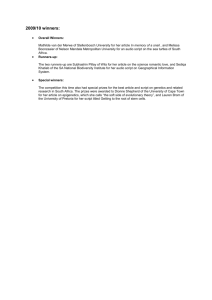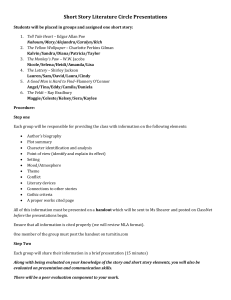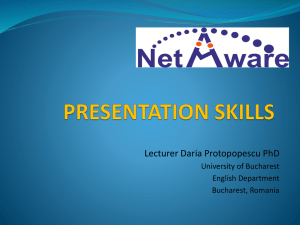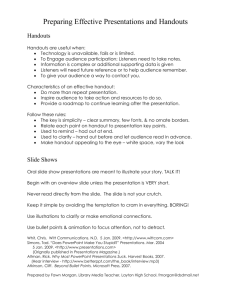Key Steps to Effective Presentations
advertisement
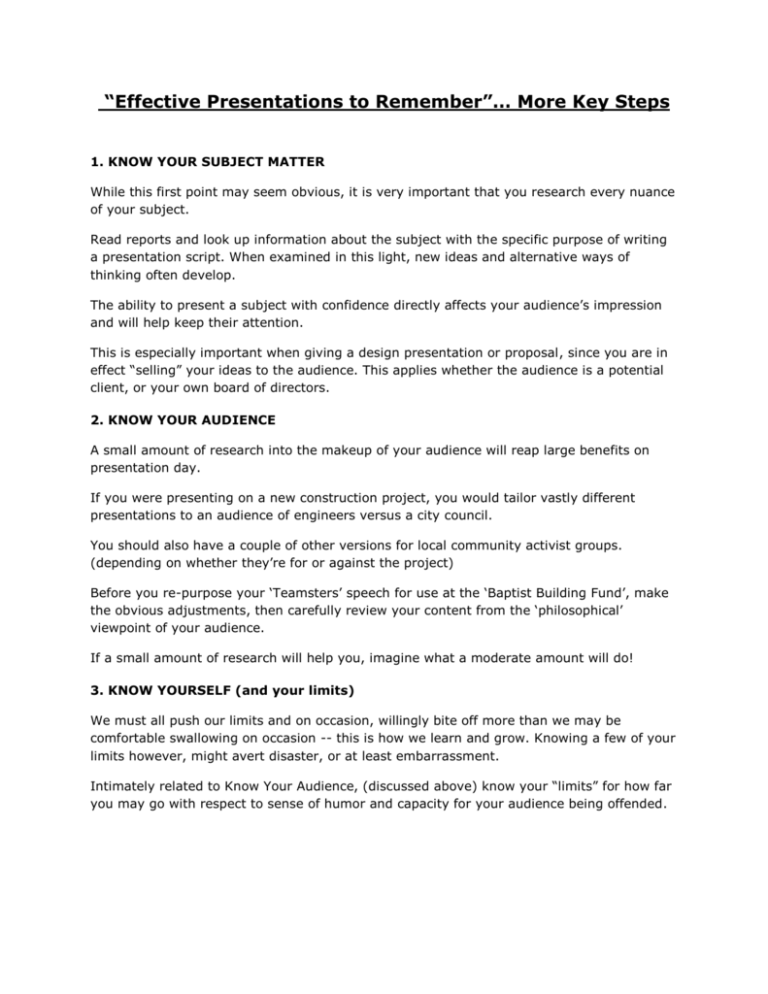
“Effective Presentations to Remember”… More Key Steps 1. KNOW YOUR SUBJECT MATTER While this first point may seem obvious, it is very important that you research every nuance of your subject. Read reports and look up information about the subject with the specific purpose of writing a presentation script. When examined in this light, new ideas and alternative ways of thinking often develop. The ability to present a subject with confidence directly affects your audience’s impression and will help keep their attention. This is especially important when giving a design presentation or proposal, since you are in effect “selling” your ideas to the audience. This applies whether the audience is a potential client, or your own board of directors. 2. KNOW YOUR AUDIENCE A small amount of research into the makeup of your audience will reap large benefits on presentation day. If you were presenting on a new construction project, you would tailor vastly different presentations to an audience of engineers versus a city council. You should also have a couple of other versions for local community activist groups. (depending on whether they’re for or against the project) Before you re-purpose your ‘Teamsters’ speech for use at the ‘Baptist Building Fund’, make the obvious adjustments, then carefully review your content from the ‘philosophical’ viewpoint of your audience. If a small amount of research will help you, imagine what a moderate amount will do! 3. KNOW YOURSELF (and your limits) We must all push our limits and on occasion, willingly bite off more than we may be comfortable swallowing on occasion -- this is how we learn and grow. Knowing a few of your limits however, might avert disaster, or at least embarrassment. Intimately related to Know Your Audience, (discussed above) know your “limits” for how far you may go with respect to sense of humor and capacity for your audience being offended. 4. DEVELOP A THEME All presentations, regardless of their complexity, are designed with a single purpose. Whether that purpose is to sell, educate, or for pure entertainment, state that purpose at the beginning of the development process. Keep this purpose in mind at all times. 5. PREPARE YOUR OWN PERSONAL SCRIPT The script does not necessarily have to be a work of literary excellence. For some, simple notes on 3 x 5 file cards are sufficient. Other presenters and presentations require a carefully composed, professionally developed script. The exact form of the script depends on the formality of the presentation, the size and demographics of the audience, and of course, the presenter. Any presentation script, regardless of complexity, shares the four basic parts of other business correspondence: opening, body, summary and closing. OPENING The opening of the presentation sets the stage for what is to follow. Participants are introduced and the purpose of the presentation is stated. You should also present a VERY BRIEF summary or outline of the points to be covered. BODY This is the part of the script in which the bulk of the subject matter is presented. The body of a long presentation should be separated into smaller, easily assimilated modules. Each module or sub-section should make a single point or convey one idea. These sub-sections should each have their own simple opening, body and summary. SUMMARY This portion should be very brief and simple. Here is your chance to reinforce the central theme and purpose of your presentation. Briefly emphasize the key points and main ideas of your script in this section. There is an old axiom that says … “Tell them what you are going to tell them, tell them, and then tell them what you told them.” This pretty much sums it up. Question and answer sessions often follow a final summary and are very productive if managed properly. Encourage questions from the audience if time permits, but be prepared to answer them. If you do not know the correct answer to a question, don’t try to fake it. Refer the question to someone who can correctly answer it or make a note to yourself to obtain the answer later. When you do, contact the person(s) who asked it as soon as possible. This makes an excellent door opener for follow-up calls. CLOSING In a well-structured closing, points raised during the question and answer session (if any) are summarized, and any handout material that was not required during the presentation is distributed. Handout material emphasizing key points and ideas enables your audience to review the subject, and assures that your words will remain fresh in their minds. Handout material should not be distributed before a presentation unless it is critical to the theme since it invariably leads to audience distraction. 6. SELECT THE PROPER VISUAL AIDS With the script developed and the audience research completed, this decision should be simple. A five-minute presentation to a three person audience is probably best made with handout material alone, or even simple flip charts. The resolution, brightness and price of computer/video projectors mean that home-brew laptop-based video projector presentations are now the norm. Major presentations at annual meetings, trade shows, sales conferences, and presentations to stockholders or client proposals might still dictate an extreme effort with professionally produced special effects, video and any and all glitz and expense. Tablet Computers are becoming popular presentation tools for small groups, informal meetings and remote learning. One of the disadvantages of streaming your presentation to tablets or laptops in the audience is that those attendees tend to develop tunnel vision. Your vocal inflections and body language, both important communications tools, may end up outside of their sensory sphere. Good presentation visuals, regardless of the display medium, do not have to be expensive. When properly planned and produced, simple, well designed graphics add professionalism and impact to virtually any show. The proper use of text images, as well as the correct type of chart or graph to use in various circumstances, is the subject of another article in this series. 7. PRODUCE THE VISUALS If the previous steps have been carefully followed, this can be the easiest part of preparing your presentation. With careful planning, the only task remaining is the mechanical process of production. The complete and accurate planning that you have done to this point assures a smooth production cycle without the need for unnecessary last minute changes. This is true whether you use markers to draw flip charts on a newsprint pad, or use a nine projector presentation with live satellite video. Today’s presentation software allows for last minute changes and additions that could not be accomplished using any other method of production. While last minute changes are possible, avoiding them can still help cut the cost of your presentation by eliminating revision and rush fees. 8. REHEARSE–REHEARSE–REHEARSE Your final script and outline or story board permit you to rehearse your presentation even before the visuals are completed. This assures that when your final images are prepared and ready, you will be as well. Record your rehearsal, make adjustments and re-record. 9. PRESENTATION DAY On the day of the presentation, arrive and set up early. Have a backup flash drive and extra copies of the handout materials. You have your visuals, you are well rehearsed, the room is set up, and the participants are all prepared. Speak clearly and with authority. A little humor can help break the tension of the moment. There should be no surprises. Make certain that the audience questions have been addressed, and of course, thank everyone for attending. 10. FOLLOW-UP Check back with the participants to assure that your presentation goals were met. A questionnaire distributed at the end of your presentation can be a source of critical information for follow-up calls or future presentations. Provide contact information to encourage the participants to contact you regarding any questions that were not answered during the presentation.
